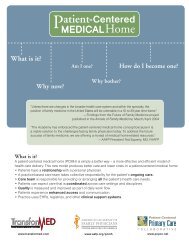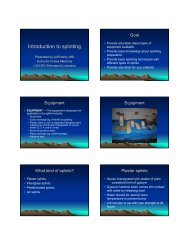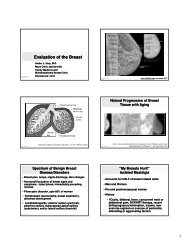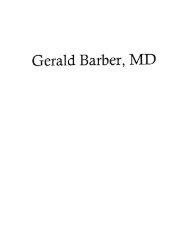New Drug Update 2009-2010 - LAFP
New Drug Update 2009-2010 - LAFP
New Drug Update 2009-2010 - LAFP
You also want an ePaper? Increase the reach of your titles
YUMPU automatically turns print PDFs into web optimized ePapers that Google loves.
19% unchanged in urine 3% unchanged in urine 30% unchanged in<br />
urine<br />
COMPARATIVE EFFICACY: Tapentadol efficacy as an analgesic was established in several pain<br />
conditions, including postoperative bunionectomy pain, dental extraction pain, and osteoarthritis. The<br />
extended-release formulation (NOT FDA approved) has been studied in osteoarthritis, chronic low back<br />
pain, and diabetic neuropathic pain.<br />
Tapentadol immediate-release was assessed in a randomized, double-blind study enrolling 269 patients<br />
with moderate to severe pain following bunionectomy surgery. Eligible patients had a postoperative pain<br />
score of at least 4 on an 11-point numerical-rating scale and an increase in pain of at least 1 point on the<br />
11-point scale within 9 hours after regional anesthesia was discontinued on the first postoperative day.<br />
Patients received tapentadol 50 or 100 mg, oxycodone immediate-release 10 mg, or placebo, with study<br />
drug taken every 4 to 6 hours over a 72-hour period starting 1 day after surgery. Oxycodone was included<br />
to demonstrate model sensitivity; the study was not powered for comparison of tapentadol with<br />
oxycodone. Rescue medication was available for patients requiring pain medication within 4 hours after<br />
the second or subsequent dose of study drug. The primary end point was the sum of pain intensity over<br />
24 hours (SPI-24) on the second day after randomization (study day 3). Mean SPI-24 values on the day 3<br />
were 33.6 for tapentadol 50 mg (P = 0.0133 vs placebo), 29.2 for tapentadol 100 mg (P = 0.0001 vs<br />
placebo), and 35.7 for oxycodone 10 mg (P = 0.0365 vs placebo) compared with 41.9 for placebo.<br />
Results from this study are summarized in Table 2. Tapentadol 50 mg was associated with a lower<br />
incidence of dizziness than oxycodone (32.8% vs 56.7%), but a similar incidence of somnolence (28.4%<br />
vs 26.9%). Tapentadol 100 mg was associated with higher rates of dizziness (64.7%) and somnolence<br />
(36.8%). GI side effects also appeared less frequently with tapentadol; however, the study was not<br />
powered for these comparisons (Curr Med Res Opin. 2008;24(11):3185-3196).<br />
Table 2. Efficacy of Tapentadol Immediate-Release Formulation in the<br />
Treatment of Postsurgical Bunionectomy Pain<br />
Tapentadol 50<br />
mg<br />
(n = 67)<br />
Tapentadol 100<br />
mg<br />
(n = 68)<br />
Oxycodone 10<br />
mg<br />
(n = 67)<br />
Mean SPI-24 on day 2 41.2 a 36.9 a 43.3 a 53.9<br />
Mean SPI-24 on day 3 33.6 b 29.2 a 35.7 b 41.9<br />
Mean SPI-24 on day 4 24.9 23.4 b 25 30.1<br />
Median time to<br />
perceptible pain<br />
relief<br />
Median time to<br />
50% pain relief<br />
Percentage rating<br />
study drug “good,”<br />
“very good,” or<br />
“excellent” on day 3<br />
Percentage receiving<br />
rescue medication<br />
Placebo<br />
(n = 67)<br />
43 min 31 min 31 min 2 h 40 min<br />
2 h 1 h 1.5 h 3.5 h<br />
64.1% 86.5% 74.2% 45.4%<br />
80.6% 76.5% 80.6% 98.5%<br />
Tapentadol immediate-release was also assessed in a subsequent randomized, double-blind, placebocontrolled<br />
study enrolling 603 patients with moderate to severe pain following bunionectomy. Patients<br />
received tapentadol 50, 75, or 100 mg, oxycodone 15 mg, or placebo every 4 to 6 hours over a 72-hour<br />
period following bunionectomy. Patients receiving rescue medication were withdrawn from the study. The<br />
primary end point was the sum of pain intensity difference (SPID) over 48 hours in the modified intent-totreat<br />
population. Mean SPID48 values were higher for all tapentadol doses and oxycodone compared<br />
71

















